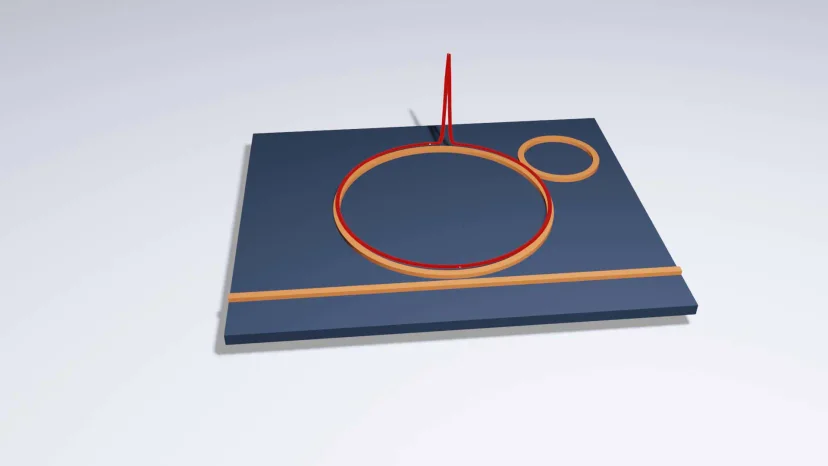
More Efficient Microcombs on the Road to Commercialization
Researchers at Chalmers University have developed a method to make microcombs 10 times more efficient, opening pathways to discovery in space and health care, and paving the way for high-performance lasers in a range of technologies. The team has established a company to commercialize the new technology.
Laser frequency combs can measure frequency with extreme levels of precision, analogous to a ruler made of light. The principle is based on a laser sending photons that circulate within a small cavity — a so-called microresonator — where the light is divided into a wide range of frequencies. These frequencies are precisely positioned in relation to each other, like the markings on a ruler. Therefore, a new kind of light source can be created consisting of hundreds, or even thousands, of frequencies, like lasers beaming in unison.

The large ring is the microresonator in which the microcomb is generated. The microcomb is formed by a pulse of light (represented by a red spike) and also known as a soliton that recirculates in the cavity indefinitely. The smaller ring helps in coupling the light from the straight waveguide, shown at the bottom as a straight orange line, into the bigger ring. In other words, it behaves as impedance matching, and therefore the soliton is generated more efficiently. Courtesy of Óskar Helgason.
Because virtually all optical measurements are connected to light frequencies, the microcomb has myriad applications, from calibrating instruments that measure signals at light-year distances in space in the search for exoplanets, to identifying and keeping track of health via exhaled air.
A fundamental problem with microcombs has been that their efficiency has been too weak to reach their transformative potential. The conversion efficiency between the laser and the microcomb was too weak, meaning that only a fraction of the power contained in the laser beam was usable.
According to Victor Torres-Company, professor of photonics at Chalmers, the new method breaks what was believed to be a fundamental limit for optical conversion efficiency. The method increases the laser power of the soliton microcomb by 10 times and raises its efficiency from about 1% to more than 50%.
Rather than using just one microresonator, the new method uses two. They form a unique ensemble with properties greater than the sum of its parts. One of the resonators enables the light coming from the laser to couple with the other resonator; similar to impedance matching in electronics.
According to the researchers, the high conversion efficiency and uniform spectrum make the devices ideal for applications in optical communications and dual-comb spectroscopy. With further engineering of the coupling region and dispersion, the researchers believe the results pave the way for the realization of octave-spanning microcombs and self-referencing using only integrated components.
Additionally, a shifted resonance can be achieved in multiple different systems, and it is not limited to the coupled-cavity design that the researchers have presented. As such, they said, the work provides important insights for realizing high-efficiency solitons using other schemes, like photonic crystal resonators or linearly coupled transverse modes, and, potentially, when using a feedthrough pump cavity.
The technology was recently patented and the researchers founded Iloomina AB, a company that will launch the technology onto a wider market.
According to Torres-Company, the new microcombs enable high-performance laser technology in numerous markets. “For example, frequency combs could be used in lidar modules for autonomous driving, or in GPS satellites and environmental sensing drones, or in data centers to enable bandwidth-intensive AI apps,” he said.
The research was published in Nature Photonics (www.doi.org/10.1038/s41566-023-01280-3).
Published: September 2023